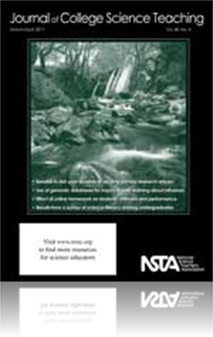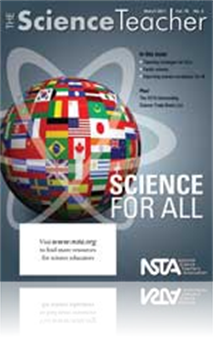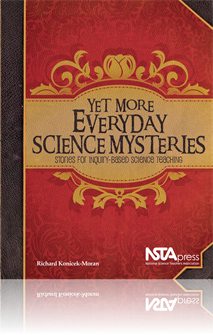All Resources
Journal Article
Point of View: When Problems on Exams Are Harder Than the Identical Problems in the Homework
Have you ever had a student approach you after an exam, asserting that the problems on the exam were much harder than the homework you assigned—yet the test problems were taken directly from the homework? (OK, maybe some numbers were changed to pro...
Journal Article
The development of students’ science reasoning abilities is a goal of science education. Researchers measure science reasoning using a variety of instruments, each with limitations and restrictions. In this study, contrasting instructional modes we...
Journal Article
A Learning Cycle for All Students
The National Science Education Standards are designed to provide a vision of scientific literacy for all students—regardless of age, race, ethnic background, English-language proficiency, socioeconomic status, disability, or giftedness. One of the ...
Journal Article
Every Day Science Calendar: March 2011
Facts and challenges for the science explorer....
Journal Article
Outstanding Science Trade Books for Students K-12 (Books Published in 2010)
Science is passion, science is wonder. The best books about science stir the minds and hearts of readers in very special ways and this impression can last for years. These books published in 2010, identify the best in science trade books for young re...
Journal Article
Five Strategies to Support All Teachers
Five strategies are outlined that have been used with elementary school teachers as they moved from a "cookbook" approach in science to an approach that is inquiry based. Suggestions to get off the slippery slope of "cookbook" science teaching....
Journal Article
This column identifies and corrects misinformation in the classroom. This month’s issue explores claims of extraterrestrial life and our efforts to communicate with inhabitants of worlds outside our solar system. Even though there's no "proof posit...
Journal Article
Students’ Perceptions of Using Personal Response Systems (“Clickers”) With Case in Science
The authors explored whether a new pedagogy using personal response systems (clickers) along with case study teaching improved students’ perceptions of their understanding of science in large introductory biology classrooms. Twelve faculty from nin...
Journal Article
Guest Editorial: Inquiry Is Essential
An opinion piece about teaching children science as inquiry and the challenges to elementary teachers. One specific challenge is incorporating full inquiries as part of the school science program. With the process described here, elementary teachers ...
Journal Article
Teaching Science to ELLs, Part II
Despite the burgeoning numbers of English language learners (ELLs) in our schools, many science teachers have little training in meeting their specialized needs. By the year 2010, it is estimated that 40% of K–12 classrooms in the United States wil...
Journal Article
Case Study: In Case You Are Interested—Results of a Survey of Case Study Teachers
Case study teaching had a long tradition in law and business before it made the jump to medical school education in the form of Problem-Based Learning (PBL) in the 1970s. Today, both the University of Delaware’s Clearinghouse and the University of ...
Journal Article
Teaching Science to ELLs, Part I
Since 1995, the population of English language learners (ELLs) in the United States has increased by an astonishing 57% (Maxwell 2009). Though ELLs come from many different backgrounds, they share the common challenge of learning English while respon...
Journal Article
Research and Teaching: Online Homework, Help or Hindrance? What Students Think and How They Perform
To improve students’ retention rates in general chemistry, online homework was introduced into our curriculum. Replacing quizzes directly by online homework significantly improved (p < .0005) success rates in second-term general chemistry. Attitudi...
Journal Article
Outstanding Science Trade Books for Students K–12 (Books published in 2010)
What makes an outstanding book for a young reader? Although it would be hard to create a rubric for every book, experienced teachers recognize them quickly. They fascinate and captivate with both their content and style. Award-winning trade books ins...
Journal Article
Idea Bank: Selecting Software for Students With Learning and Other Disabilities
Have you ever bought a computer program that you thought would be great for your struggling students, only to find that it did not work on your school computers, or that your students found it difficult to use? Selecting science software for students...
Journal Article
JCST Sunsets Favorite Demonstration Column
The Journal of College Science Teaching announces that this long-running column will be discontinued. We will continue to publish those articles which have been previously accepted, but we will no longer accept new manuscripts for this column. We wis...
Journal Article
The New Teacher's Toolbox: Combating Cheating in the Classroom
Cheating is nothing new—students have been finding ways to do it for years. Though you'll never be able to catch every cheater, there are some steps you can take to minimize cheating in your classroom. This month's column provides tips that take li...
Book Chapter
This book, and particularly the stories which lie within, provide an opportunity for students to take ownership of their learning and learn science in a way that will give them a more positive attitude about science. In addition, it will serve to hel...
Book Chapter
The story, in this chapter, is meant to show students the importance of leavening agents in making baked goods. Yeast, a living organism (a fungus), is necessary for baking risen yeast breads. This fungus can be ineffective if it is not healthy. The ...
Book Chapter
Springtime in the Greenhouse: Planting Season
Children and adults alike are prone to believe that if a little of something is good, more is better. In the case of this story, your students will probably believe that if fertilizer is good for growing plants, it must be good for germinating seeds....
Book Chapter
Students may have the impression that all kinds of reaction time responses can be improved through practice. They may believe also that every kind of stimulus produces the same kind of reaction time. The story, in the chapter, provides the opportun...
Book Chapter
In this chapter, this story really leaves us hanging! It’s a great one for real investigation! There are two purposes of the story: the first is to investigate closed systems. Anything that happens inside uses up only the materials in the jar, beca...
Book Chapter
Melting and dissolving are two of the most often misunderstood concepts in both child and adult populations. Many children believe that when a substance dissolves in a solvent it does not exist any longer. This chapter’s story’s purpose is to a...
Book Chapter
Your students will probably not be able to distinguish between heat and temperature as concepts. The main purpose of this chapter and story is to help students understand the dynamics of heat energy transfer. Another purpose is for them to understand...
Book Chapter
Students often focus more on the visible properties of objects, like shininess, than the material of which they are actually made. In this chapter, the story will allow students to become aware that some materials give up and take in thermal energy ...
Book Chapter
The story in this chapter has two purposes. One is to apply what is known about pendulums to a new problem and the other is to use technical skills to solve a problem. The swing operates on the principles of periodic motion and the crooked branch, up...
Book Chapter
This chapter’s story is based a bit on the ESS (Elementary Science Study) activity “Mystery Powders.” The problem with the original activity was that the students were introduced to the tests for various ingredients without a motivating hook. A...
Book Chapter
Your students will probably not consider friction to be a force. In this chapter, the story focuses on friction, both static and kinetic. Jimmy had trouble overcoming the static friction that needed a pushing force to get him started and then had t...
Book Chapter
Using the Book and the Stories
It is often difficult for overburdened teachers to develop lessons or activities that are compatible with the everyday life experiences of their students. A major premise of this book is that if students can see the real-life implications of science ...
Book Chapter
Using the Book in Different Ways
Although the book was originally designed for use with K–8 students by teachers or adults in informal settings, it became obvious that a book containing stories and content material for teachers who are intent on teaching in an inquiry mode had oth...
Book Chapter
There is currently a strong effort to combine science and literacy, because a growing body of research stresses the importance of language in learning science. Discussion, argumentation, discourse of all kinds, group consensus, and social interaction...
Book Chapter
The purpose of this story used in this chapter is to help students learn about the source of heat energy that warms their planet. Of course that is the Sun, and it only has an effect on the temperature of the Earth when it is shining on a particula...
Book Chapter
The author’s research and that of others show that children have a difficult time understanding the recycling of organic matter in an ecosystem. The story in this chapter aims to have students speculate about what happens to organic material over t...
Book Chapter
What’s the Moon Like Around the World?
A great deal of confusion arises from the lack of understanding about the Moon’s journey around the Earth and its apparent shape changes. This investigation is aimed at confronting this confusion by looking at the Earth-Moon system and how it appea...
Book Chapter
Astronomical rules are not always correct, especially when they use the word “always.” Students should learn that unless they live on or very near the equator, there are only two days in the year that the Sun rises directly in the east—the sp...
Book Chapter
Lichens are everywhere, yet most people fail to notice them because they are so familiar. The story in this chapter was written to help persuade teachers to acquaint their students with these unique forms of life. Many biology teachers tend to gloss ...








